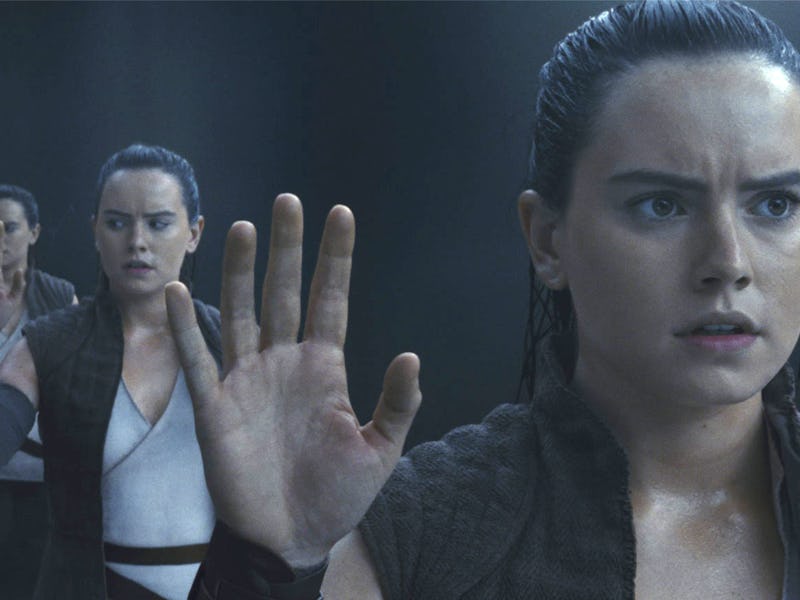Star Wars Is About to Get its Biggest Reboot Since 2015
Star Wars is daring to do the one thing it almost never does — create a sequel.

In Star Wars, the basic day-to-day status quo of the entire galaxy can change in less than a decade. Although the core Star Wars saga — everything from Phantom Menace to Rise of Skywalker — is epic and sweeping, we’re only talking about a period of time that is less than seven decades total. But, within all of that, there are some massive pivots. And, because of that tradition, the specific timeframe of the upcoming Rey-centric Rise of Skywalker sequel suggests another massive continuity reset is coming. Here’s why.
Speaking at Star Wars Celebration 2023 in London, Lucasfilm CEO Kathleen Kennedy confirmed that the newly announced Jedi Master Rey sequel will take place “about 15 years outside of The Rise of Skywalker.” To be clear, this forward-looking sequel won’t just happen a few years after the end of Episode IX, but, instead, a decade and a half later. Which, if you squint, is kinda how Star Wars tends to always roll with its time jumps. Just enough time for things to be familiar-ish, but also a big enough gap that a lot can have changed in a relatively short interval.
Leslye Headland, Dave Filoni, and Kathleen Kennedy at Star Wars Celebration 2023.
To put it another way, the time jump between The Rise of Skywalker and the start of this new sequel is roughly about the same as the gap between the end of Revenge of the Sith and the beginning of Andor. Consequently, the gap between the first two George Lucas trilogies is only 19 years, but obviously, the galaxy feels way different in A New Hope than it did in Revenge of the Sith. Since the release of the prequels, we’ve had shows and movies explore that in-between time (Solo, Rebels, Obi-Wan Kenobi, again, Andor Season 1) but, all of those series are retroactive, and if you look at the chronological leap from the prequels to the sequels, you’re dealing with a kind of soft reboot in both directions.
Meanwhile, the gap between Return of the Jedi and The Force Awakens was even bigger — about three decades. Since then, that period of time has also experienced some retcon, specifically with the shows connected to the Mandalorian’s continuity. Some fans even think that the Dave Filoni-directed Mando-verse movie will also be a kind of reboot; a film that fills in the gaps in the story of the New Republic and could, possibly bring back Lando, Han, Luke, and Leia, again. This theorizing implies that additional retcon is coming to the existing timeline — but what makes the Rey movie interesting is that there’s no retcon required.
Rey in The Rise of Skywalker.
Like The Force Awakens in 2015, what’s somewhat novel about the Rey movie is that it is a straightforward sequel, albeit with a time-jump cushion. The time jump also makes a bit of sense in real life; Daisy Ridley will be a decade older in 2025 than she was when The Force Awakens hit in 2015.
Although there are hours and hours of Star Wars visual content, in terms of release order, very few Star Wars things have been sequels. The Empire Strikes Back (1980) and Return of the Jedi (1983) are obviously sequels to Star Wars (1977), but beyond that, no Star Wars film, or TV series until 2015’s Force Awakens was actually a sequel. (Even the Ewok movies and Droid cartoons are prequels!)
Clearly, Kathleen Kennedy and director Sharmeen Obaid-Chinoy are aware of the huge amount of freedom a Star Wars sequel offers, simply because Star Wars sequels are so rare. “It took a lot of discussion,” Kennedy revealed to EW. “Because obviously we've been developing stories in different spaces, and television has been a big focus of our attention right now. But there's still so much interest in what happens after The Rise of Skywalker. So we're excited to be doing that."
Daisy Ridley and director Sharmeen Obaid-Chinoy at Star Wars Celebration 2023.
The future of the Jedi, is, in some ways, the future of the Force in general. While the sequel trilogy relied on preexisting characters from the classic films, the Rey/New Jedi Order movie doesn’t have that baggage at all. Sure, Mark Hamill could appear as a Force Ghost in the new film, or, hell, so could Ben Solo. But, that doesn’t feel like the point of this film at all. “The question we're going to ask with the New Jedi Order and Rey is, does the galaxy need them anymore?” Kennedy said. “Do they want them back?”
While all the new Star Wars announcements are exciting, the simplicity of the 15-year time jump of the New Jedi Order movie is perhaps the most refreshing. Going back to an even longer time ago in a galaxy, far, far away has proven to be the default setting for most Star Wars projects. But, now, maybe Rey can really become the Chosen One simply by helping this prequel-obsessed franchise turn the page.
There are no release dates set for the next three Star Wars movies.
This article was originally published on